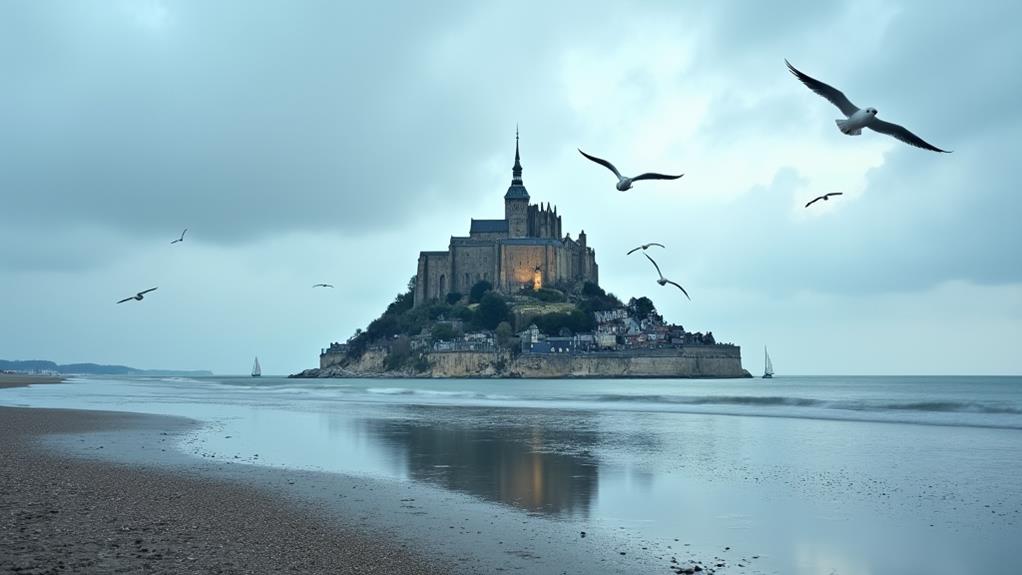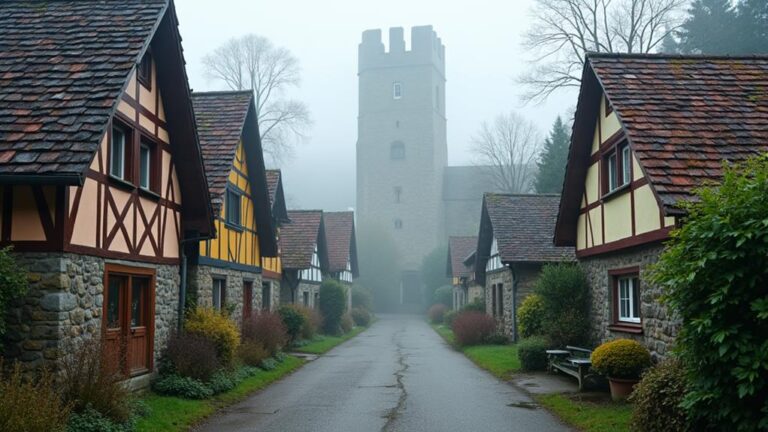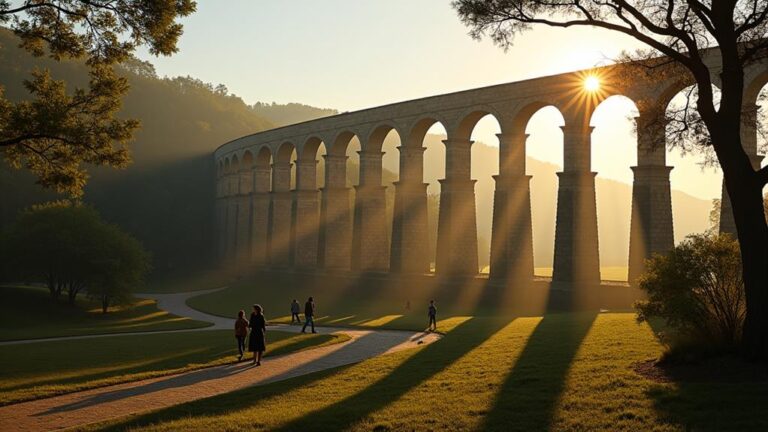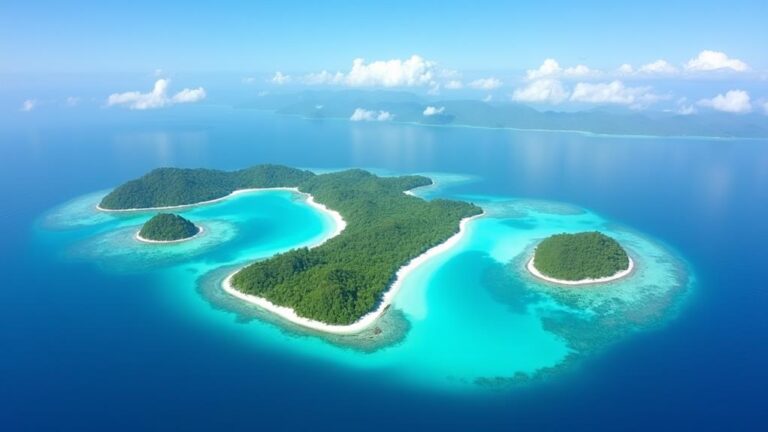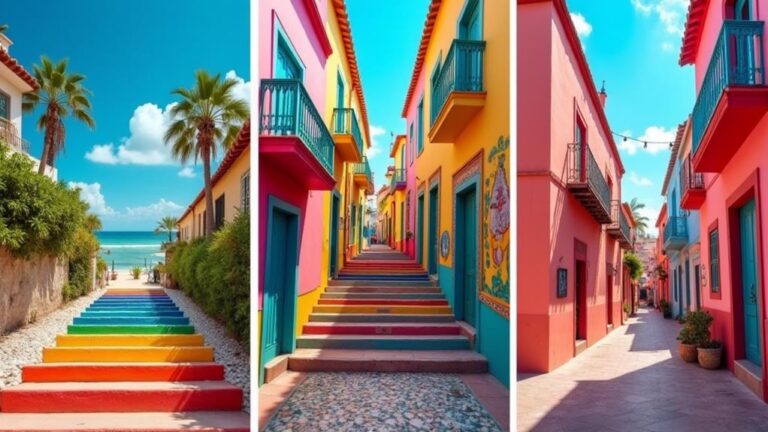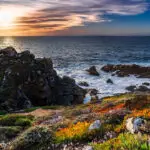You've likely heard of Mont Saint-Michel in France, with its stunning abbey perched atop a tiny island that's only accessible during low tide. But it's not the only famous tidal island out there. From England's St Michael's Mount and Holy Island of Lindisfarne to lesser-known gems like Osea Island and Cramond Island, these unique landmasses have captivated visitors for centuries. What draws people to these enchanting places, and what secrets lie beneath their tidal rhythms? As you explore these islands, you'll discover the fascinating stories and ecosystems that set them apart.
Contents
Key Takeaways
- Mont Saint-Michel in France is a famous tidal island known for its rapid tidal changes and UNESCO World Heritage site status.
- St Michael's Mount in England is a historic tidal island with a stunning castle and picturesque village.
- The Holy Island of Lindisfarne in England is a tidal island with a rich history, unique wildlife, and scenic landscapes.
- Burgh Island in Devon, England is a tidal island with a unique geology, luxurious accommodations, and a historic pillbox.
- Jindo Island in South Korea is a famous tidal island known for its scenic coastline, tidal flats, and island-hopping activities.
Mont Saint-Michel in France
Approaching the Normandy coast in northern France, you'll find the picturesque tidal island of Mont Saint-Michel, situated approximately 1 kilometer off the mainland.
This iconic site is characterized by French architecture, with a striking abbey perched atop a granite outcrop, surrounded by vast bay and towering walls.
Mont Saint-Michel has been a UNESCO World Heritage site since 1979, attracting millions of visitors each year.
Geologically, the island is a result of the combination of tectonic uplift and erosion.
The surrounding bay, known as the Bay of Mont Saint-Michel, is prone to rapid tidal changes, with water levels rising by as much as 14 meters in a short period.
This unique tidal environment has led to concerns about coastal erosion, which poses a threat to the island's structural integrity.
Conservation efforts are in place to mitigate the effects of coastal erosion, including the construction of a dam to regulate water flow and a new bridge to replace the existing causeway.
These measures aim to preserve the island's delicate ecosystem and guarantee the long-term sustainability of this remarkable tidal island.
St Michael's Mount in England
Located off the coast of Cornwall in southwestern England, St Michael's Mount bears a striking resemblance to Mont Saint-Michel in France. You'll notice the similarity in their tidal island landscapes and imposing castle architecture. St Michael's Mount is a small island with an area of approximately 57 acres, and it's connected to the mainland by a causeway that's accessible at low tide.
| Location Features | Tidal Characteristics | Island Statistics |
|---|---|---|
| Off the coast of Cornwall | Subject to high and low tides | 57 acres in area |
| Connected to Marazion | Tides vary with lunar cycles | 30 meters above sea level |
| Part of the Mount's Bay | Strong tidal currents | 0.5 km from the mainland |
| Home to St Michael's Mount Castle | Tidal range of 7 meters | Owned by the National Trust |
| Steeped in tidal legends | Tides affect island access | Popular tourist destination |
As you explore St Michael's Mount, you'll discover the rich history and tidal legends surrounding the island. The castle architecture is a legacy to the island's strategic importance and its ability to withstand the harsh marine environment. With its unique tidal characteristics and stunning castle, St Michael's Mount is a must-visit destination for anyone interested in tidal islands and their fascinating histories.
Osea Island in Essex
You're now moving to the eastern coast of England, where Osea Island in Essex awaits.
Located in the Blackwater Estuary, this island is accessible via a causeway that's exposed at low tide, allowing you to explore its unique wildlife habitats.
As you explore the island, you'll uncover its rich history, which spans centuries of human settlement and changing ownership.
Access to the Island
Frequently, visitors to Osea Island in Essex rely on a combination of land and water routes to access the island.
As Osea Island is cut off from the mainland at high tide, you'll need to plan your trip carefully. To access the island, you'll first need to drive to the town of Maldon, which is about 10 miles from the island.
From Maldon, take the B1026 road to the village of Steeple, where you'll find the island's causeway. It's vital to check the tide timetables before heading to the island, as the causeway is only accessible at low tide.
Once you've crossed the causeway, you'll arrive on the island's western shore. Alternatively, you can take a ferry from Maldon Quay, which operates on a regular schedule during peak season.
Be sure to check the ferry schedules in advance to plan your trip accordingly. By coordinating your visit with the tides and ferry schedules, you'll be able to enjoy all that Osea Island has to offer.
The island's unique tidal nature requires some planning, but the scenic views and tranquil atmosphere make it well worth the effort.
Island Wildlife and Habitat
As Osea Island's unique tidal environment constantly shifts, its diverse wildlife has adapted to the changing landscape.
You'll find that the island's coastal ecosystems support a rich variety of flora and fauna. The island's shoreline, with its mix of sandy beaches, rocky shores, and salt marshes, provides a habitat for a wide range of species.
The island's marine biodiversity is particularly notable, with its waters home to numerous fish species, crustaceans, and mollusks.
You may spot species such as oystercatchers, avocets, and redshanks, which are attracted to the island's shoreline and intertidal zones. The island's salt marshes also provide a crucial habitat for plants such as sea purslane and sea lavender, which are adapted to the island's saline conditions.
As you explore the island, you'll notice the dynamic interaction between the island's wildlife and its ever-changing environment.
The island's unique tidal regime, with its rapid changes in water levels, creates a constantly shifting landscape that supports a diverse range of plant and animal species.
Island History and Ownership
Osea Island, situated off the coast of Essex, has a rich and varied history that spans thousands of years.
You'll discover that this tidal island has been home to numerous inhabitants throughout the centuries. As you explore into its past, you'll find that the island's history is deeply intertwined with its unique geography.
Island archaeology has revealed evidence of human habitation dating back to the Mesolithic period, around 6,000 years ago.
You'll notice that the island's strategic location made it an ideal spot for early settlers, who likely exploited the island's natural resources and tidal patterns.
The Romans also left their mark on the island, with archaeological finds suggesting they used it as a stopping point for trade and commerce.
In more recent times, Osea Island has been privately owned, with various families and individuals playing a significant role in shaping its history.
As a tidal islander, you'll appreciate the challenges and opportunities that come with living on an island that's connected to the mainland at low tide.
Today, the island remains a popular destination for those interested in its unique history and natural beauty.
Holy Island of Lindisfarne
Located off the northeastern coast of England, near the Scottish border, the Holy Island of Lindisfarne beckons you to explore its unique tidal island landscape.
This island, also known as Holy Island, is a place where the tides shape not only the coastline but also the lives of its inhabitants.
The tidal island's unique geography has given rise to numerous legends and stories surrounding the island.
Lindisfarne legends often revolve around the island's spiritual significance. As a place of island spirituality, Lindisfarne has been a site of pilgrimage and reflection for centuries.
- Tidal Causeway: The island is connected to the mainland by a tidal causeway, which is only accessible at low tide.
- Historic Monastery: The island is home to the ruins of a 7th-century monastery, which was an important center of learning and spirituality.
- Wildlife Habitat: The island's unique tidal landscape supports a wide range of wildlife, including seabirds, seals, and fish.
As you explore the Holy Island of Lindisfarne, you'll discover a place where the natural and spiritual worlds intersect.
Cramond Island in Scotland
Explore the eastern coast of Scotland and you'll discover Cramond Island, a small, tidal island situated in the Firth of Forth, near Edinburgh.
You can access this island by walking along the tidal causeway that connects it to the mainland at low tide. The causeway is approximately 0.8 miles long and is only accessible during low tide. Be cautious, as the tide can come in quickly.
Cramond Island offers stunning views of the Firth of Forth, the Forth Bridges, and the surrounding coastline.
The island features beautiful beaches, rocky shores, and a variety of wildlife. You can walk around the island, exploring its scenic coastline, and visit the remains of World War II gun emplacements and pillboxes.
If you plan to visit Cramond Island, take advantage of the tidal walks along the causeway and the beaches.
Cramond beaches offer a unique opportunity to explore the island's coastline at low tide. Make sure to check the tide times before you go, and be mindful of the tide's rapid movement.
Burgh Island in Devon
You'll find Burgh Island off the coast of Bigbury-on-Sea in Devon, England, where it's been shaped by its unique geological history.
As you explore this tidal island, you'll notice its distinctive features, including a sandy beach and the ruins of a 14th-century chapel.
Located near the mouth of the River Avon, Burgh Island's position has influenced its development, from its early history to its current status as a popular destination.
Island History and Development
Discovering Burgh Island's rich history and development requires understanding its unique geological formation and strategic significance.
As you explore this tidal island, you'll uncover the remnants of a 14th-century chapel, which is a chronicle to the island's early settlement.
The island's tidal formation created a natural barrier, protecting its inhabitants from invaders.
As you excavate into the island's history, you'll discover that its strategic location made it an ideal spot for a fortified settlement.
- Medieval Settlement: Archaeological findings suggest that the island was inhabited during the medieval period, with evidence of a chapel and other buildings.
- Smuggling and Piracy: The island's remote location and tidal formation made it an attractive spot for smugglers and pirates, who used the island as a hideout.
- Military Significance: During World War II, the island was used as a military base, with the construction of a pillbox and other defensive structures.
Island archaeology has revealed a complex history of human activity on Burgh Island, with a rich cultural heritage that spans centuries.
Location and Geography Features
Burgh Island's strategic location off the coast of Devon, England, plays a significant role in its unique geography.
As you explore this tidal island, you'll notice its proximity to the mainland, which affects its island formation. The island is situated near the mouth of the River Avon, and its position has led to the formation of a sandy beach and a series of rocky outcrops.
The island's geology is primarily composed of Devonian sandstone and slate, which are resistant to weathering.
However, the constant pounding of waves against the shore has led to coastal erosion, particularly during high tides and storms. The island's western side has been heavily eroded, resulting in the formation of a small cove.
The erosion process is ongoing, and it continues to shape the island's landscape.
As a tidal island, Burgh Island is also influenced by the tides, which have played a vital role in its formation.
The island's size and shape change depending on the tide, and its sandy beach is constantly being reshaped by the incoming and outgoing tides.
Access and Accommodations Available
Visitors to this tidal island in Devon, England, can access Burgh Island at low tide via a sandy causeway.
As you plan your Tidal Treks and Island Getaways, ponder the island's unique accessibility. When the tide is in, a sea tractor is available to transport you to the island. This tractor was originally designed by Robert "Leon" Serpol, the island's previous owner.
To make the most of your visit, a few accommodations and services are worth contemplating:
- Burgh Island Hotel: This luxurious hotel is the island's main accommodation and offers stunning views of the sea.
- Beachside Cottages: These self-catering cottages are perfect for families or groups looking for a more relaxed getaway.
- Local Cafes and Restaurants: The island has a few cafes and restaurants that serve delicious seafood and local specialties.
Keep in mind that accommodations on the island are limited, so booking in advance is crucial.
With its unique tidal access and beautiful scenery, Burgh Island is an ideal destination for those looking for a peaceful and secluded getaway.
Chapel Island in Canada
Situated off the coast of Cape Breton, Nova Scotia, Canada, Chapel Island is a small tidal island with a rich history and unique geology.
As you explore this island, you'll notice the effects of coastal erosion, which have shaped its shoreline over thousands of years.
The constant pounding of waves against the island's rocks has created a rugged coastline with many inlets and coves.
The island's isolation has also contributed to its unique geology.
The tidal flats surrounding the island are a haven for marine life, and the island's solitude has allowed its ecosystem to thrive.
You'll find a variety of plants and animals that are adapted to the island's harsh, saltwater environment.
As you walk along the island's shoreline, you'll notice the mix of sand, pebbles, and rocks that make up the beach.
The island's geology is a result of the interaction between the sea and the land, and it continues to evolve with each passing tide.
Despite the forces of erosion that shape it, Chapel Island remains a unique and fascinating destination for those interested in exploring the natural world.
Jindo Island in South Korea
As you shift your focus from the rugged coastlines of Canada to the shores of East Asia, you'll find another unique tidal island in South Korea – Jindo Island.
Located in the Yellow Sea, Jindo Island is the third-largest island in South Korea and is known for its scenic coastline and tidal flats.
1. Tidal Flats: Jindo Island is famous for its tidal flats, which are exposed at low tide and submerged at high tide.
This unique phenomenon creates a habitat for various marine life, including shellfish and migratory birds.
2. Sea Walls: The island has an extensive network of sea walls that protect the coastal areas from erosion and flooding.
These walls also serve as a barrier against strong tidal currents.
3. Island Hopping: Visitors to Jindo Island can explore the surrounding islands, including Modo Island and Ullimsanbang Beach.
Island hopping is a popular activity, offering stunning views of the Yellow Sea and the surrounding tidal flats.
Jindo Island is a fascinating destination for those interested in tidal islands and marine ecosystems.
With its unique tidal flats, extensive sea walls, and opportunities for island hopping, Jindo Island is a must-visit destination in South Korea.
Frequently Asked Questions
Are Tidal Islands Suitable for People With Mobility Issues?
You might think tidal islands are off-limits for people with mobility issues, but with accessible paths and island adaptations, many are surprisingly accessible, allowing you to explore these unique environments with some planning and assistance.
Can Visitors Bring Pets to Tidal Islands?
You're planning a trip with your furry friend, and it's a coincidence you're considering islands too. When visiting tidal islands, you're often allowed pets, but check pet rules and respect island etiquette to preserve habitats and wildlife.
Are Tidal Island Beaches Safe for Swimming?
When swimming at beaches with strong tidal influences, you'll want to exercise caution. Rip currents can be a hazard, and varying water quality may pose health risks, so it's essential you check conditions before entering the water.
Are the Tidal Islands Open Year-Round to Visitors?
You navigate the islands like a ship through uncharted waters, but be aware that access can be limited during low season, and some areas may close due to weather or maintenance, affecting year-round visits.
Can I Stay Overnight on a Tidal Island?
You can stay overnight on a tidal island, but crucial to research tidal island camping regulations and available island accommodation options, considering factors like tide times, accessibility, and environmental impact to plan your stay safely.
Conclusion
As you explore these famous tidal islands, you'll witness Mont Saint-Michel's fortressed shores, St Michael's Mount's rugged coastline, Osea Island's serene wetlands, Holy Island of Lindisfarne's historic ruins, Cramond Island's rocky shores, Burgh Island's sandy beaches, Chapel Island's vast wilderness, and Jindo Island's migratory bird sanctuaries. You'll experience rapid tidal shifts, diverse ecosystems, and unique geological features that set these islands apart. Each one offers a distinct glimpse into the complex interplay of land, sea, and life.

